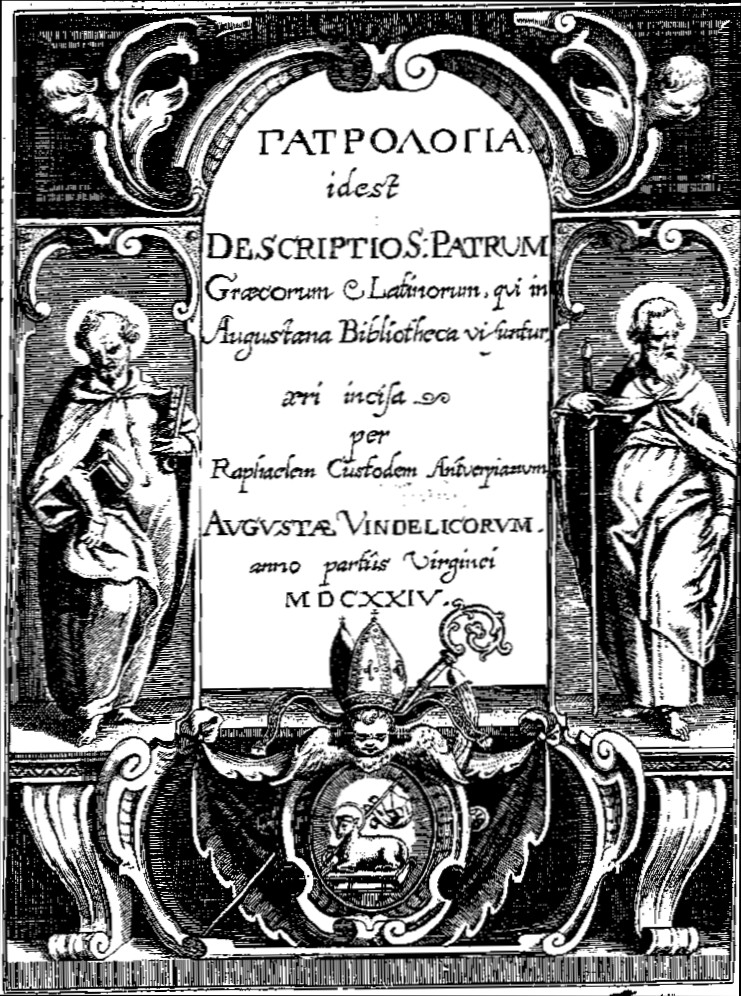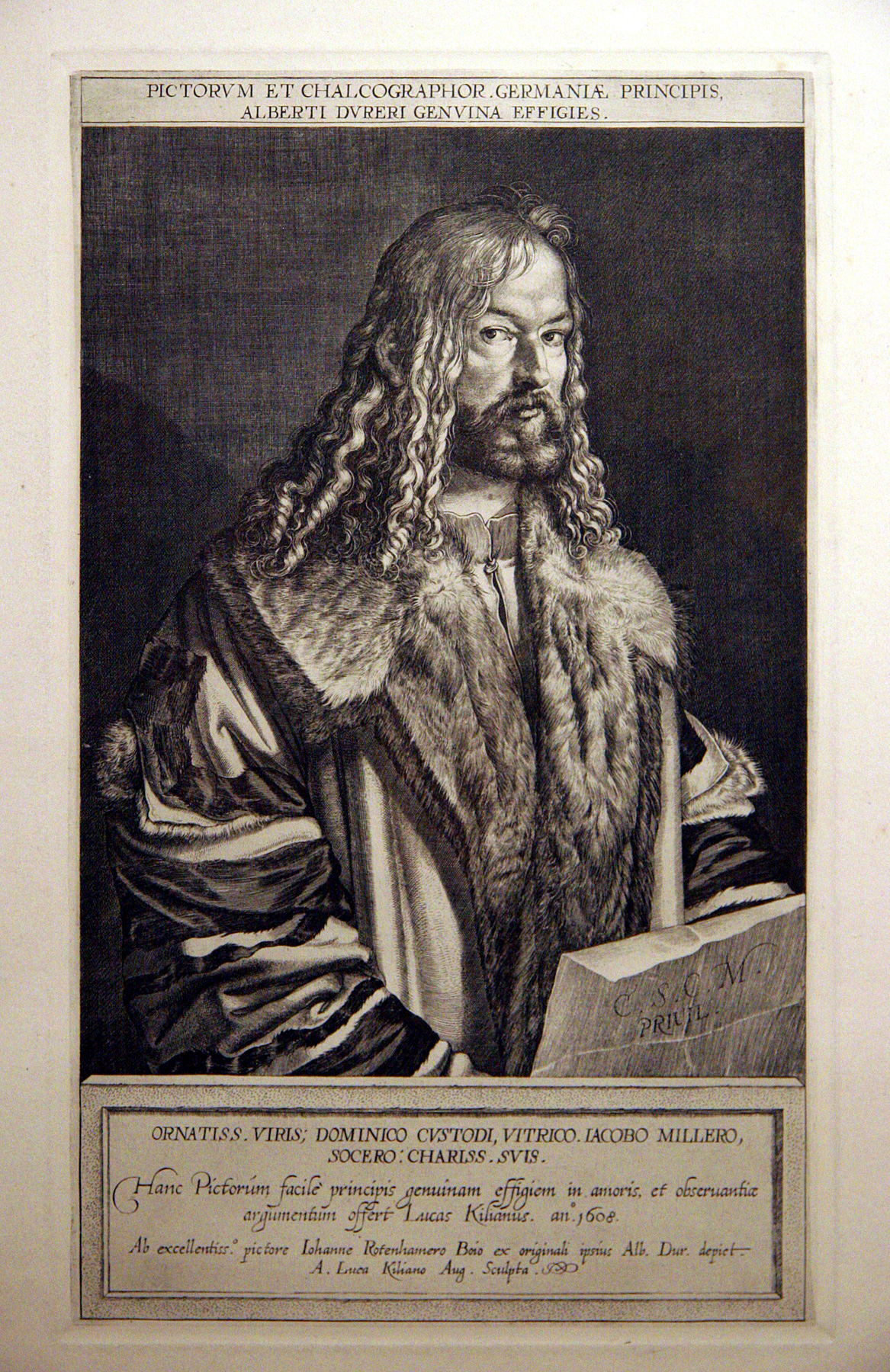|
Raphael Custos
Raphael Custos, or Custodis (1590–1664), was a German engraver and member of the Kilian family of engravers in Augsburg. Biography He was born in Augsburg as the oldest biological son of Dominicus Custos and Maria Pfeiffelmann, who already had two sons by her first marriage, Lucas and Wolfgang Kilian. His parents later had two more sons, David and Jacob Custos, and they all became pupils of their father Dominicus.Raphael Custos in the RKD After his father's death in 1612, Raphael continued the family workshop. Though his stepbrothers began their own workshops in Augsburg, they remained in close collaboration, as Raphael did not travel himself, but stayed to run family affairs while his brothers made business trips. Works * ''Emblemata sac ...[...More Info...] [...Related Items...] OR: [Wikipedia] [Google] [Baidu] |
Patrologia 1624
Patristics or patrology is the study of the early Christian writers who are designated Church Fathers. The names derive from the combined forms of Latin ''pater'' and Greek ''patḗr'' (father). The period is generally considered to run from the end of New Testament times or end of the Apostolic Age () to either AD 451 (the date of the Council of Chalcedon) or to the Second Council of Nicaea in 787. Eras The Church Fathers are generally divided into the Ante-Nicene Fathers, those who lived and wrote before the Council of Nicaea (325) and the Nicene and Post-Nicene Fathers, those who lived and wrote after 325. Also, the division of the Fathers into Greek and Latin writers is also common. Some of the most prominent Greek Fathers are Justin Martyr, Athanasius of Alexandria, Basil of Caesarea, Gregory of Nazianzus, John Chrysostom, Cyril of Alexandria, and Maximus the Confessor. Among the Latin Fathers are Tertullian, Cyprian, Jerome, Ambrose of Milan, Augustine of ... [...More Info...] [...Related Items...] OR: [Wikipedia] [Google] [Baidu] |
Augsburg
Augsburg (; bar , Augschburg , links=https://en.wikipedia.org/wiki/Swabian_German , label=Swabian German, , ) is a city in Swabia, Bavaria, Germany, around west of Bavarian capital Munich. It is a university town and regional seat of the ''Regierungsbezirk'' Schwaben with an impressive Altstadt (historical city centre). Augsburg is an urban district and home to the institutions of the Landkreis Augsburg. It is the third-largest city in Bavaria (after Munich and Nuremberg) with a population of 300,000 inhabitants, with 885,000 in its metropolitan area. After Neuss, Trier, Cologne and Xanten, Augsburg is one of Germany's oldest cities, founded in 15 BC by the Romans as Augusta Vindelicorum, named after the Roman emperor Augustus. It was a Free Imperial City from 1276 to 1803 and the home of the patrician Fugger and Welser families that dominated European banking in the 16th century. According to Behringer, in the sixteenth century, it became "the dominant centre of early cap ... [...More Info...] [...Related Items...] OR: [Wikipedia] [Google] [Baidu] |
Dominicus Custos
Dominicus Custos (1560–1612) was a Flemish artist, printer and copperplate engraver, who worked in the service of Emperor Rudolph II in Prague. Dominicus was born in Antwerp, the son of Pieter Balten, and settled in Augsburg as the second husband of the widow of Bartholomäus Kilian (1548–1588), a goldsmith from Silesia and the father of Wolfgang and Lukas Kilian; they were trained by Dominicus in the art of engraving after their father's death. Dominicus was the father of David Custodis, also an Augsburg engraver. Custos and the humanist Marcus Henning collaborated in producing the work ''"Tirolensium principum comitum"'' which appeared in 1599 and depicted 28 Counts of Tyrol from Albert IV (1190–1253) to Rudolf II (1552–1612). Custos was responsible for the engravings while Henning took care of the text and eulogies. (see The Spanish Hall at Schloss Ambras) Between 1602 and 1604 he published the ''"Atrium heroicum"'' in four parts. This was a collection of 171 eng ... [...More Info...] [...Related Items...] OR: [Wikipedia] [Google] [Baidu] |
Lucas Kilian
Lucas Kilian (1579 – 1637) was a German engraver and member of the Kilian family of engravers in Augsburg. Biography He was the son of Bartholomaus Kilian the elder and Maria Pfeiffelmann. After his father's death in 1588 his mother remarried Dominicus Custos and he and his brother Wolfgang became his pupils.Lucas Kilian in the RKD Kilian's engraved portrait of Albrecht Dürer, based on a Dürer self-portrait from a copy of Dürer's '' Feast of the Rosary'' by |
Wolfgang Kilian
Wolfgang Kilian (1581–1662) was a German engraver and member of the Kilian family of engravers in Augsburg. Biography He was the son of Bartholomaus Kilian the elder and Maria Pfeiffelmann. After his father's death in 1583 his mother remarried Dominicus Custos and he and his brother Lucas became his pupils.Wolfgang Kilian in the RKD From 1604–1608 he travelled in Italy and worked in Venice, Mantua, and Milan. On his return he married and continued in the family workshop. He was the father of the engravers Bartholomaus the younger and . References Sources [...More Info...] [...Related Items...] OR: [Wikipedia] [Google] [Baidu] |
Emblem Book
An emblem book is a book collecting emblems (allegorical illustrations) with accompanying explanatory text, typically morals or poems. This category of books was popular in Europe during the 16th and 17th centuries. Emblem books are collections of sets of three elements: an icon or image, a motto, and text explaining the connection between the image and motto. The text ranged in length from a few lines of verse to pages of prose. Emblem books descended from medieval bestiaries that explained the importance of animals, proverbs, and fables. In fact, writers often drew inspiration from Greek and Roman sources such as Aesop's Fables and Plutarch's Lives. Definition Scholars differ on the key question of whether the actual emblems in question are the visual images, the accompanying texts, or the combination of the two. This is understandable, given that first emblem book, the '' Emblemata'' of Andrea Alciato, was first issued in an unauthorized edition in which the woodcuts ... [...More Info...] [...Related Items...] OR: [Wikipedia] [Google] [Baidu] |
Otto Van Veen
Otto van Veen, also known by his Latinized name Otto Venius or Octavius Vaenius (1556 – 6 May 1629), was a painter, draughtsman, and humanist active primarily in Antwerp and Brussels in the late 16th and early 17th centuries. He is known for running a large studio in Antwerp, producing several emblem books, and for being, from 1594 or 1595 until 1598, Peter Paul Rubens' teacher. His role as a classically educated humanist artist (a ''pictor doctus''), reflected in the Latin name by which he is often known, Octavius Vaenius, was influential on the young Rubens, who would take on that role himself. Life Van Veen was born around 1556 in Leiden, where his father, Cornelis Jansz. van Veen (1519–1591), had been Burgomaster.Van de Velde. He probably was a pupil of Isaac Claesz van Swanenburg until October 1572, when the Catholic family moved to Antwerp, and then to Liège. He studied for a time under Dominicus Lampsonius and Jean Ramey, before traveling to Rome around 1574 or ... [...More Info...] [...Related Items...] OR: [Wikipedia] [Google] [Baidu] |
Artnet
Artnet.com is an art market website. It is operated by Artnet Worldwide Corporation, which has headquarters in New York City, in the United States, and is owned by Artnet AG, a German publicly traded company based in Berlin that is listed on the Frankfurt Stock Exchange. The company increased revenues by 25.3% to 17.3 million EUR in 2015 compared with a year before. Company history The company was founded as Centrox Corporation in 1989 by Pierre Sernet, a French collector who developed database software which allowed images of artworks to be associated with market prices. Hans Neuendorf, a German art dealer, began to invest in the company in the 1990s; he became chairman in 1992 and chief executive officer A chief executive officer (CEO), also known as a central executive officer (CEO), chief administrator officer (CAO) or just chief executive (CE), is one of a number of corporate executives charged with the management of an organization especial ... in 1995. That s ... [...More Info...] [...Related Items...] OR: [Wikipedia] [Google] [Baidu] |
1590 Births
Year 159 ( CLIX) was a common year starting on Sunday (link will display the full calendar) of the Julian calendar. At the time in Roman territories, it was known as the Year of the Consulship of Quintillus and Priscus (or, less frequently, year 912 ''Ab urbe condita''). The denomination 159 for this year has been used since the early medieval period, when the Anno Domini calendar era became the prevalent method in Europe for naming years. Events By place India * In India, the reign of Shivashri Satakarni, as King Satavahana of Andhra, begins. Births * December 30 – Lady Bian, wife of Cao Cao (d. 230) * Annia Aurelia Fadilla, daughter of Marcus Aurelius * Gordian I, Roman emperor (d. 238) * Lu Zhi, Chinese general (d. 192) Deaths * Liang Ji, Chinese general and regent A regent (from Latin : ruling, governing) is a person appointed to govern a state ''pro tempore'' (Latin: 'for the time being') because the monarch is a minor, absent, incapacitated or u ... [...More Info...] [...Related Items...] OR: [Wikipedia] [Google] [Baidu] |
1664 Deaths
It is one of eight years (CE) to contain each Roman numeral exactly once (1000(M)+500(D)+100(C)+50(L)+10(X)+(-1(I)+5(V)) = 1664). Events January–March * January 5 – In the Battle of Surat in India, the Maratha leader, Chhatrapati Shivaji, defeats the Mughal Army Captain Inayat Khan, and sacks Surat. * January 7 – Indian entrepreneur Virji Vora, described in the 17th century by the English East India Company as the richest merchant in the world, suffers the loss of a large portion of his wealth when the Maratha troops of Shivaji plunder his residence at Surat and his business warehouses. * February 2 – Jesuit missionary Johann Grueber arrives in Rome after a 214-day journey that had started in Beijing, proving that commerce can be had between Europe and Asia by land rather than ship. * February 12 – The Treaty of Pisa is signed between France and the Papal States to bring an end to the Corsican Guard Affair that began on August 20, 1662 ... [...More Info...] [...Related Items...] OR: [Wikipedia] [Google] [Baidu] |






.jpg)